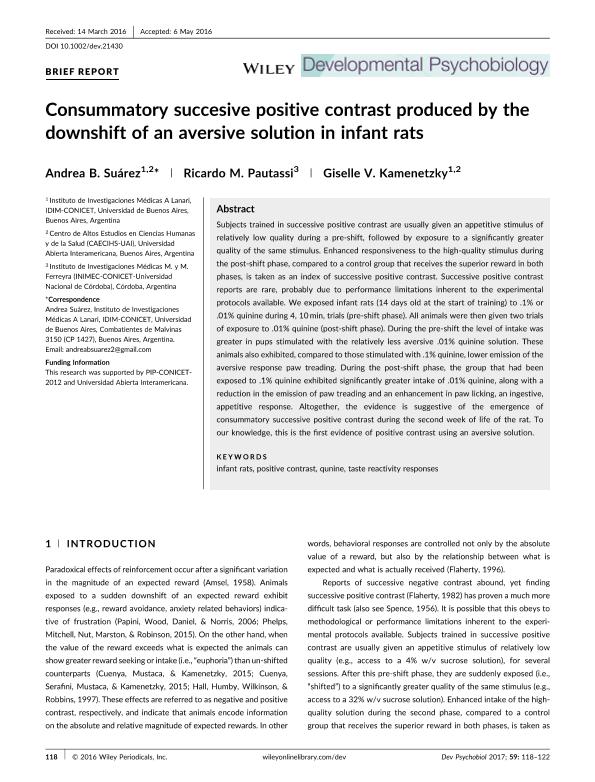Artículo
Consummatory succesive positive contrast produced by the downshift of an aversive solution in infant rats
Fecha de publicación:
01/2017
Editorial:
John Wiley & Sons Inc
Revista:
Developmental Psychobiology
ISSN:
0012-1630
Idioma:
Inglés
Tipo de recurso:
Artículo publicado
Clasificación temática:
Resumen
Subjects trained in successive positive contrast are usually given an appetitive stimulus of relatively low quality during a pre‐shift, followed by exposure to a significantly greater quality of the same stimulus. Enhanced responsiveness to the high‐quality stimulus during the post‐shift phase, compared to a control group that receives the superior reward in both phases, is taken as an index of successive positive contrast. Successive positive contrast reports are rare, probably due to performance limitations inherent to the experimental protocols available. We exposed infant rats (14 days old at the start of training) to .1% or .01% quinine during 4, 10 min, trials (pre‐shift phase). All animals were then given two trials of exposure to .01% quinine (post‐shift phase). During the pre‐shift the level of intake was greater in pups stimulated with the relatively less aversive .01% quinine solution. These animals also exhibited, compared to those stimulated with .1% quinine, lower emission of the aversive response paw treading. During the post‐shift phase, the group that had been exposed to .1% quinine exhibited significantly greater intake of .01% quinine, along with a reduction in the emission of paw treading and an enhancement in paw licking, an ingestive, appetitive response. Altogether, the evidence is suggestive of the emergence of consummatory successive positive contrast during the second week of life of the rat. To our knowledge, this is the first evidence of positive contrast using an aversive solution.
Palabras clave:
Positive_Contrast
,
Quinine
,
Taste_Reactivity_Responses
,
Infant_Rats
Archivos asociados
Licencia
Identificadores
Colecciones
Articulos(IDIM)
Articulos de INST.DE INVEST.MEDICAS
Articulos de INST.DE INVEST.MEDICAS
Articulos(INIMEC - CONICET)
Articulos de INSTITUTO DE INV. MEDICAS MERCEDES Y MARTIN FERREYRA
Articulos de INSTITUTO DE INV. MEDICAS MERCEDES Y MARTIN FERREYRA
Citación
Suarez, Andrea Beatriz; Pautassi, Ricardo Marcos; Kamenetzky, Giselle Vanesa; Consummatory succesive positive contrast produced by the downshift of an aversive solution in infant rats; John Wiley & Sons Inc; Developmental Psychobiology; 59; 1; 1-2017; 118-122
Compartir
Altmétricas




